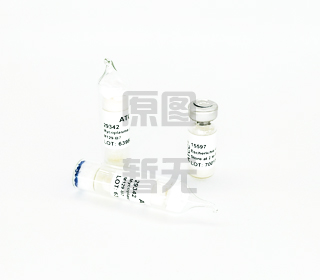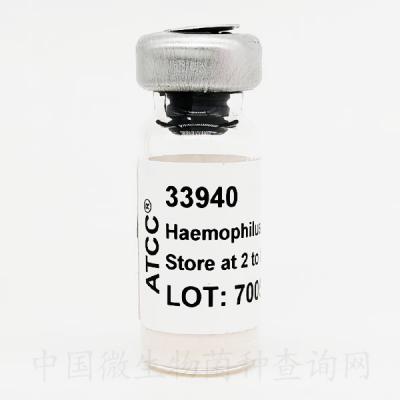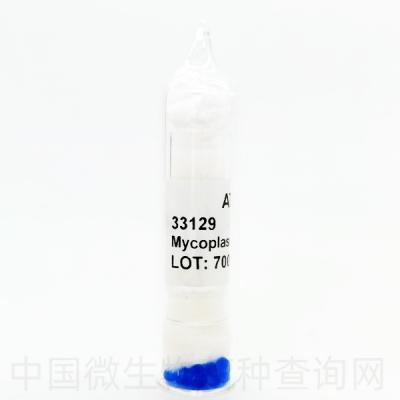
ATCC® Number:11745™
Organism: Crithidia fasciculata Leger
Designations: Anopheles
Isolation: mosquito, Anopheles quadrimaculatus, Ashokan, NY, 1926 (<--- H.N. Guttman strain Anopheles (1964) <--- . . . <--- Noguchi and Tilden -- Anopheles quadrimaculatus, 1926)
Depositors: SH Hunter
History: ATCC<<--SH Hunter<<--A. Lwoff <<--- H. Noguchi
Biosafety Level:1
Shipped: frozen
Growth Conditions: ATCCmedium 355: Crithidia mediumTemperature: 25.0°C Duration: axenic Protocol: ATCCNO: 11745 SPEC: See general instructions for thawing and storage of frozen material before proceeding. Add thawed contents to a single 16 x 125 mm glass screw-capped test tube of the appropriate medium. Incubate the culture vertically with the cap screwed on tightly. It is essential to establish cultures initially in small volumes. Once established, the culture can be scaled up to larger volumes. Vigorously agitate the culture and aseptically transfer 0.1 ml of culture to a fresh tube of medium weekly.
Permits/Forms: In addition to the MTA mentioned above, other ATCC and/or regulatory permits may be required for the transfer of this ATCC material. Anyone purchasing ATCC material is ultimately responsible for obtaining the permits. Please click here for information regarding the specific requirements for shipment to your location.
Applications: assay of biopterin [45903] produces dihydrofolate reductase [5026]
Comments: Auxotrophic mutants [4982] species description [4825] Ornithine-arginine metabolism [4786] Dihydrofolate reductase: thymidylate synthase [5026] Riboprinting and taxonomy [23607] Proteinases [23752] Toxicity of 4-nitroquinoline l-oxide [23782] Properties of NAD-specific glutamate dehydrogenase [23849] use of plastic ampoules for freeze preservation [23870] presences in feces of lizards fed culture forms of the flagellates [23942] Polyamines [23962] Effects of hydroxyurea [23980] Regulation of aerobic fermentation by malic enzyme. [23982] Tubulin heterogeneity [23996] Acetylornithinase and ornithine acetyltransferase [24012] isoenzyme electrophoresis for species identification [24036] Cyclopropane fatty acid [24043] Ultrastructural differences between species with and without endosymbionts [24077] Effect of ethidium bromide on the oxidative metabolism [24113] isoleucine requirement and threonine deaminase [24118] Regulation of aerobic fermentation [24127] Dense growth and heme sparing [24131] Reconstruction of the mitochondrion [24135] Prescreen for potential trypanocides [24149] Multiple distinct site-specific elements in miniexon arrays [24177] Structure of the d-mannan and D-arabino-d-galactan [24188] use of mutants in detecting genetic recombination [24190] endonuclease-generated fragments of K-DNA, esterase isoenzymes, surface proteins for species identification [24216] Polyamine function [23571] Cysteine and metalloproteinase activities [23887] Ultrastructural reconstruction of the mitochondrion [24135] effect of temperature and osmolarity on growth [30421]
Cross References: Nucleotide (GenBank) : Y08233 C.fasciculata gene encoding ornithine decarboxylase.
References: 4584: . . J. Exp. Med. 44: 307, 1926. 4786: Figueiredo EN, et al. Enzymes of the ornithine-arginine metabolism of trypanosomatids of the genus Crithidia. J. Protozool. 25: 546-549, 1978. 4821: De Menezes MC, Roitman I. Nutritional requirements of Blastocrithidia culicis, a trypanosomatid with an endosymbiont. J. Protozool. 38: 122-123, 1991. 4825: Faria e Silva PM, et al. Herpetomonas roitmani (Fiorini et al., 1989) n. comb.: a trypanosomatid with a bacterium-like endosymbiont in the cytoplasm. J. Protozool. 38: 489-494, 1991. PubMed: 1920148 4982: Garcia LA, Roitman I. Auxotrophic mutants of Crithidia fasciculata. J. Parasitol. 76: 739-740, 1990. PubMed: 2120414 5026: Ferone R, Roland S. Dihydrofolate reductase: thymidylate synthase, a bifunctional polypeptide from Crithidia fasciculata. Proc. Natl. Acad. Sci. USA 77: 5802-5806, 1980. PubMed: 6934511 21844: Gueugnot J, et al. Etude comparative de la fixation de lectines ur les membranes de quatre expeces de Crithidia. Protistologica 16: 33-38, 1980. 23571: Bacchi CJ, et al. Polyamine function in trypanosomatids: activation of cytoplasmic alpha-glycerophosphate dehydrogenase by cationic trypanocides. Adv. Polyamine Res. 2: 129-138, 1978. 23607: Clark CG. Riboprinting: A tool for the study of genetic diversity in microorganisms. J. Eukaryot. Microbiol. 44: 277-283, 1997. PubMed: 9225441 23752: Coombs GH. Proteinases of Leishmania mexicana and other flagellate protozoa. Parasitology 84: 149-155, 1982. PubMed: 6460959 23782: Leon W, et al. Toxicity of 4-nitroquinoline l-oxide for Crithidia fasciculata. J. Protozool. 22: 277-280, 1975. PubMed: 50443 23849: Higa AI, et al. Some properties of NAD-specific glutamate dehydrogenase from Crithidia fasciculata. J. Gen. Microbiol. 113: 429-432, 1979. 23870: Simione FP Jr., et al. The use of plastic ampoules for freeze preservation of microorganisms. Cryobiology 14: 500-502, 1977. PubMed: 891238 23887: Branquinha MH, et al. Ubiquity of cysteine-and metalloproteinase activites in a wide range of trypanosomatids. J. Eukaryot. Microbiol. 43: 131-135, 1996. PubMed: 8720943 23942: Dollahon NR, et al. Herpetomonas megaseliae, Crithidia fasciculata, and Leptomonas collosoma (Kinetoplastida, Trypanosomatidae) in feces of lizards fed culture forms of the flagellates. J. Protozool. 30: 58-62, 1983. 23962: Bacchi CJ, et al. Polyamines in trypanosomatids. J. Bacteriol. 131: 657-661, 1977. PubMed: 885842 23980: Cosgrove WB, et al. Effects of hydroxyurea on Crithidia fasciculata. J. Protozool. 26: 643-648, 1979. PubMed: 94609 23982: Marr JJ. Crithidia fasciculata: regulation of aerobic fermentation by malic enzyme. Exp. Parasitol. 33: 447-457, 1973. PubMed: 4146226 23996: Russell DG, et al. Tubulin heterogeneity in the trypanosome Crithidia fasciculata. Mol. Cell. Biol. 4: 779-790, 1984. PubMed: 6717441 24012: Galinari S, Camargo EP. Trypanosomatid protozoa: survey of acetylornithinase and ornithine acetyltransferase. Exp. Parasitol. 46: 277-282, 1978. PubMed: 569594 24036: Goncalves de Lima VM, et al. Five trypanosomatid species of insects distinguished by isoenzymes. J. Protozool. 26: 648-652, 1979. PubMed: 161788 24043: Fish WR, et al. The cyclopropane fatty acid of trypanosomatids. Mol. Biochem. Parasitol. 3: 103-115, 1981. PubMed: 7254247 24077: Freymuller E, Camargo EP. Ultrastructural differences between species of trypanosomatids with and without endosymbionts. J. Protozool. 28: 175-182, 1981. PubMed: 7024533 24113: Manaia AC, Roitman I. Effect of ethidium bromide on the oxidative metabolism and enzyme profiles of Crithidia fasciculata. J. Protozool. 24: 192-195, 1977. PubMed: 864623 24118: Alfieri SC, Camargo EP. Trypanosomatidae: isoleucine requirement and threonine deaminase in species with and without endosymbionts. Exp. Parasitol. 53: 371-380, 1982. PubMed: 6806116 24127: Marr JJ, et al. Crithidia fasciculata: appearance kinetics of intermediates and regulation of aerobic fermentation. Exp. Parasitol. 42: 322-330, 1977. PubMed: 18361 24131: Shapiro A, et al. Dense Crithidia growth and heme sparing: relation to Fe, Cu, Mo chelation. J. Protozool. 25: 530-534, 1978. PubMed: 33264 24135: Paulin JJ. Crithidia fasciculata: Reconstruction of the mitochondrion based on serial thick sections and high-voltage electron microscopy. Exp. Parasitol. 41: 283-289, 1977. PubMed: 321237 24149: Shapiro A, et al. Rapid in vitro prescreen for chelators as potential trypanocides based on growth of Crithidia fasciculata. J. Protozool. 28: 370-377, 1981. PubMed: 7310745 24177: Teng SC, et al. A new non-LTR retrotransposon provides evidence for multiple distinct site-specific elements in Crithidia fasciculata miniexon arrays. Nucleic Acids Res. 23: 2929-2936, 1995. PubMed: 7659515 24182: Sontheimer RD, Gilliam JN. An immunofluorescence assay for double-stranded DNA antibodies using the Crithidia luciliae kinetoplast as a double-stranded DNA substrate. J. Lab. Clin. Med. 91: 550-558, 1978. PubMed: 347011 24188: Gorin PA, et al. Structure of the D-mannan and D-arabino-D-galactan in Crithidia fasciculata: changes in proportion with age of culture. J. Protozool. 26: 473-478, 1979. PubMed: 536936 24190: Glassberg J, et al. Isolation and partial characterization of mutants of the trypanosomatid Crithidia fasciculata and their use in detecting genetic recombination. J. Protozool. 32: 118-125, 1985. PubMed: 3857343 24216: Camargo EP, et al. Electrophoretic analysis of endonuclease-generated fragments of k-DNA, of esterase isoenzymes, and of surface proteins as aids for species identification of insect trypanosomatids. J. Protozool. 29: 251-258, 1982. PubMed: 6284925 30421: Da Silva JB, Roitman I. Effect of temperature and osmolarity on growth of Crithidia fasciculata, Crithidia hutneri, Crithidia thermophila, and Herpetomonas samuelpessoai. J. Eukaryot. Microbiol. 29: 269-272, 1982. 32938: Fernandes O, et al. Mini-exon gene sequences define six groups within the genus Crithidia. J. Eukaryot. Microbiol. 44: 535-539, 1997. PubMed: 9435125 34222: Cho J, Eichinger D. Crithidia fasciculata induces encystation of Entamoeba invadens in a galactose-dependent manner. J. Parasitol. 84: 705-710, 1998. PubMed: 9714198 45903: Baker H, et al. Biopterin content of human and rat fluids and tissues determined protozoologically. Am. J. Clin. Nutr. 27: 1247-1253, 1974. PubMed: 4447093





